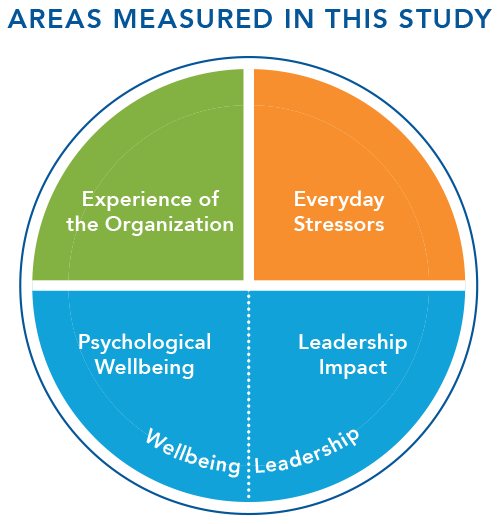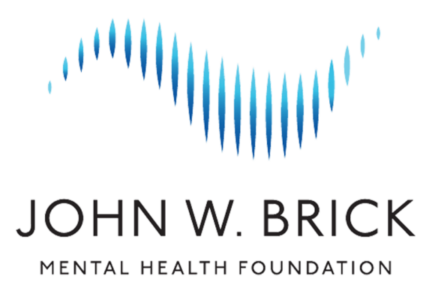Wellbeing is becoming a driver of brand performance, workforce engagement, and social and environmental change—and is one of the central challenges and opportunities of leadership today. Within work settings, applying the science and practices of wellbeing is at the top of leadership agendas to enhance the employee experience and strengthen the collaboration, adaptability, and effectiveness of people and teams, networks, and entire organizations.
This wellbeing leadership agenda is even more crucial for organizations in the health and wellbeing industry. Why? Because this industry is on the frontline of assisting with the mental, physical, and social toll that individuals, organizations, and communities often experience due to the escalating changes and complexities in every corner of our world.
Leading in the Health & Wellbeing Industry 2023 is the first time for a study to ask:
As leaders of health and wellbeing industries, are we thriving personally? Are we advancing wellbeing through how we lead?
Why Do This Study?
Recent research shows leaders globally are struggling both with their personal wellbeing and leading wellbeing for their teams and organizations. Insights from Gallup emphasize that people who are engaged at work but not thriving in their lives overall have a higher likelihood of burnout, daily stress, and worry than people who are thriving.
Yet, the most impactful wellbeing efforts don’t begin with the individual employee. Leadership has an outsized impact on people at work—recent Gallup research suggests that 70% of an employee’s work experience is due to their leader. Creating work environments where people can flourish, bring their best to work, and leave work more capable and well than when they arrived requires leaders who lead and live wellbeing. This has never been more important for industry sectors that promote the advancement of health and wellbeing as their core mission and value proposition.
WELLBEING IS AN IMPERATIVE
A 2022 Deloitte study found that 57% of employees and 70% of executives are considering quitting their job for one that better supports their wellbeing.
Leading in the Health & Wellbeing Industry 2023 provides leaders and human capital professionals a first-ever look at wellbeing leadership across the health and wellbeing industry, defined by three sectors.
GLOBAL WELLNESS ECONOMY
HEALTHCARE
HUMAN POTENTIAL & DEVELOPMENT
Described by the Global Wellness Institute as a $4.5 trillion market combining 11 categories: wellness tourism, physical activity, workplace wellness, healthy eating and weight loss, preventive and personalized medicine and public health, personal care, beauty and anti-aging, mental wellness, wellness real estate, traditional and complementary medicine, spa, and thermal/mineral springs.
A $11.9 Trillion global market, according to Research & Markets, which includes organizations that deliver medical services, manufacture, or sell medical devices or drugs, provide health insurance, or otherwise facilitate healthcare for patients.
Those professions and organizations, such as leadership development, professional training, organization development, and education, that advance the wellbeing and stress resilience, learning, and growth of people.
Everyone can be a leader.
What Do We Mean by “Leadership”?
In our contemporary work world where hierarchies and silos are beginning to give way to networks of collaboration that are more democratized, adaptive, and inclusive, we define leadership as a stance a person takes to actively steward the work conditions where all people can be effective and thrive. Who’s leading and who’s following can vary over the course of a day, a project, or a major change initiative. This means everyone can be a leader, in management and non-management roles alike.
What Did We Measure?
Health and wellbeing industry leaders answered 133 questions to examine their experience of the organization, everyday stressors, and two areas, psychological wellbeing and leadership impact, which combine into what we call wellbeing leadership. Psychological wellbeing includes 16 psychometrics that provide a window into a leader’s perceived internal resourcefulness to meet their lifework demands with a high quality of life, competence, and growth. The three psychometrics of leadership impact shed light on the leaders’ reported ability to amplify thriving for people at work.

“A focus on wellbeing is about our humanity. The health and wellbeing industry has an opportunity to take a leadership role in fostering healthier ways of living, working, and caring for ourselves, each other, and the planet. Essentially, it’s time for the industry to reconnect with the reason it exists: the health and wellbeing of all.”
—Renee Moorefield, CEO, Wisdom Works Group
Overall, nine key findings emerged from this study revealing considerable potential for health and wellbeing industry leaders to enhance wellbeing leadership for themselves and the people and organizations they serve. Role modeling—or authentically walking the wellbeing talk—is crucial, especially in an industry that the rest of the world looks to for health and wellbeing solutions and advice.
Leading in the Health & Wellbeing Industry 2023 uncovers that leaders in this industry are collectively reporting that they are not as internally well-resourced as they could be to handle the complexities and challenges they face. With leaders as a linchpin for people’s experience at work, this study brings to light the need for integrating the science and practices of wellbeing into leader development as a strategy for improving leadership, work culture, and industry impact.
 Higher Leader Wellbeing Links to Higher Leadership Impact
Higher Leader Wellbeing Links to Higher Leadership Impact
 Leaders Across the Industry Show Potential for Growth
Leaders Across the Industry Show Potential for Growth
 Human Potential & Development Leaders Report Lowest Wellbeing Leadership and Highest Stress
Human Potential & Development Leaders Report Lowest Wellbeing Leadership and Highest Stress
 Middle- and First-Line Managers Show Need for Support
Middle- and First-Line Managers Show Need for Support
 Wellbeing Leadership for Top Management Depends on Industry Sector
Wellbeing Leadership for Top Management Depends on Industry Sector
 The Experience of Work Differs Across Level of Leader
The Experience of Work Differs Across Level of Leader
 Wellbeing Leadership Varies for Gender Identity
Wellbeing Leadership Varies for Gender Identity
 Female Leaders Show Slightly Higher Stress than Male Leaders
Female Leaders Show Slightly Higher Stress than Male Leaders
 Higher Wellbeing Leadership Is Linked with Age
Higher Wellbeing Leadership Is Linked with Age
Access the Full Report
Complete the form below to dive deeper into all nine findings from Leading in Health & Wellbeing Industry 2023: Are we walking our talk?
WHY PRIORITIZE WELLBEING?
Research shows high wellbeing is linked to:
• Employee attraction and retention
• Employee health and disease prevention
• Stress resilience
• Happiness and life satisfaction
• Sustainable, high performance
• Adaptability, collaboration, and learning
• A vibrant work culture
• Customer loyalty
• Greater responsibility for people and the planet
What Does This Mean for You?
In today’s organizations, effective leadership is an inside-out job. It’s a stance you take to actively steward work conditions where all people can be effective, grow, and thrive. As a leader in the health and wellbeing industry, you cannot control what happens in the global environment. Yet, how you respond—how you lead your organization, your team, and your life—largely depends on you.
Findings from Leading in the Health & Wellbeing Industry 2023 reveal that leaders across the industry can increase their ability to face growing leadership complexities and demands by strengthening their inner wellbeing. Since this industry is the custodian for the health and wellbeing of people and societies globally, we believe a strategic focus on wellbeing-driven leadership is not optional for the industry’s business and social outcomes.
We Hope This Research Inspires New Paths of Inquiry
At Wisdom Works, we are committed to research that advances wellbeing as a path to effective leadership around the world. Although Leading in the Health & Wellbeing Industry 2023 has focused on one industry, we hope its insights contribute to new paths of inquiry benefiting all industries.
We understand that this research is, by nature, incomplete. As a first-ever study of leaders across the health and wellbeing industry, these early results draw from a population heavily focused on North America, the United Kingdom, and Europe. Plus, since leaders volunteered to take our assessment of wellbeing leadership, we assume leaders in this study may be more interested than the average leader in advancing wellbeing personally and within their organizations. This may mean the findings from this study are better than what we’d find if we randomly assessed leaders across the health and wellbeing industry.
To use content or findings from this report, please cite Leading in the Health & Wellbeing Industry 2023, Wisdom Works Group, Inc., or contact us for permission.



